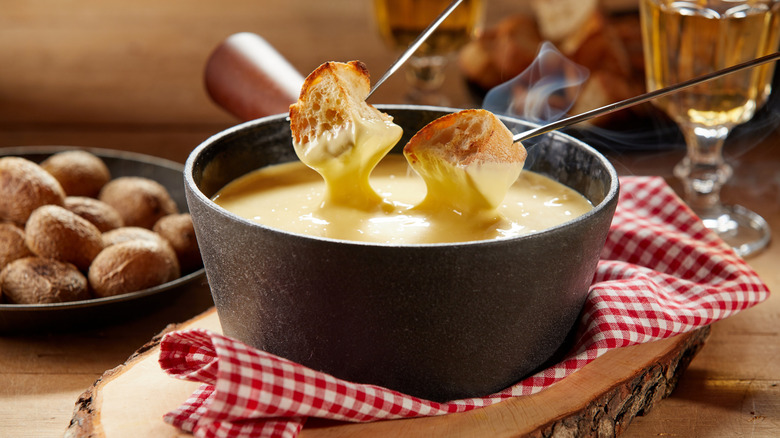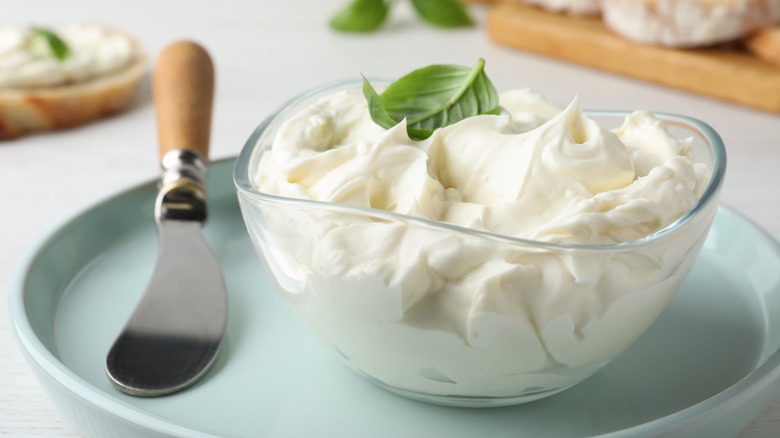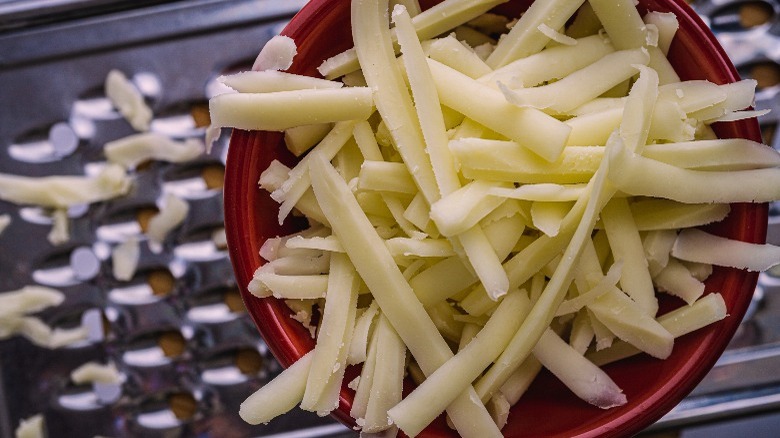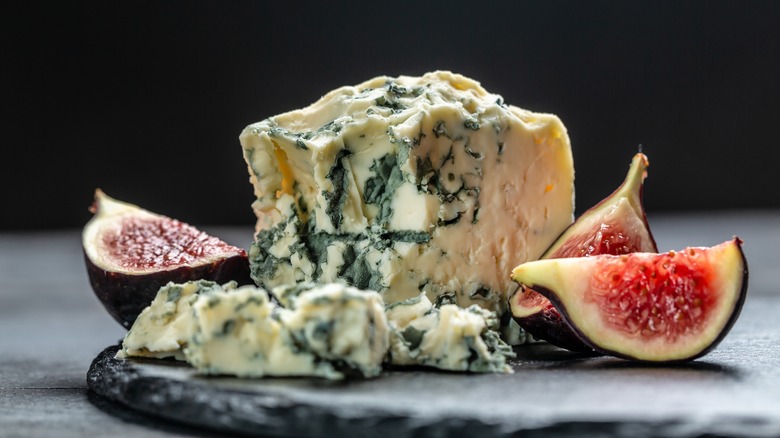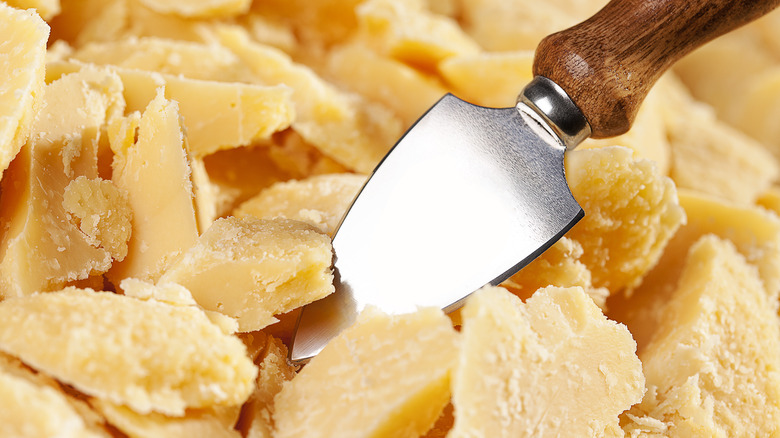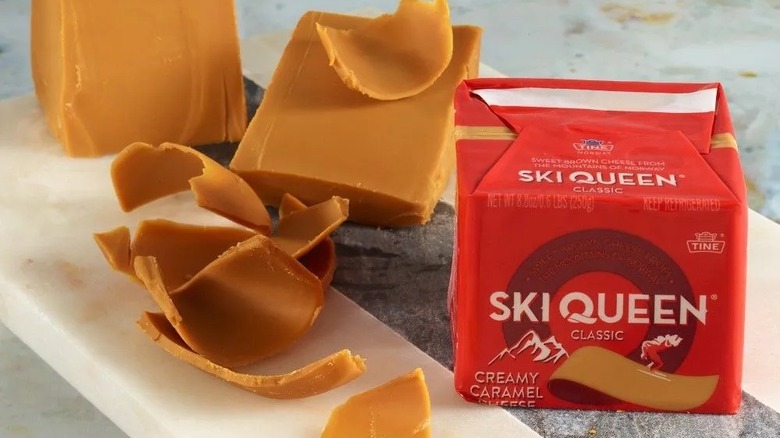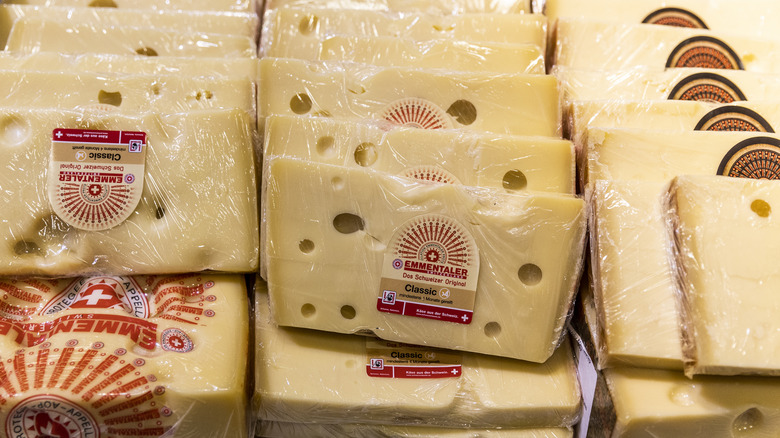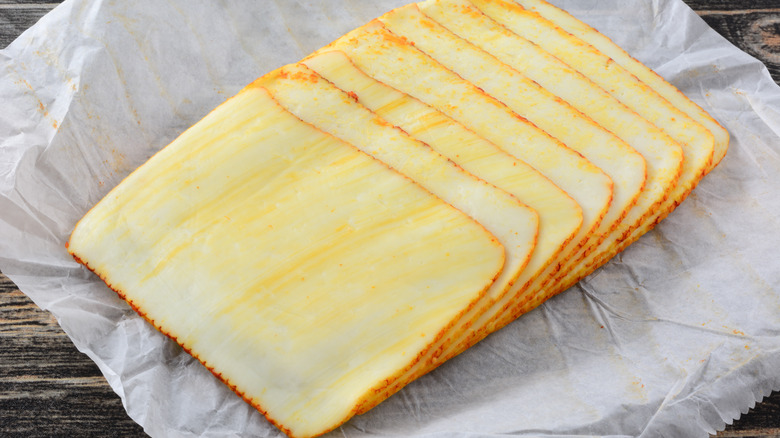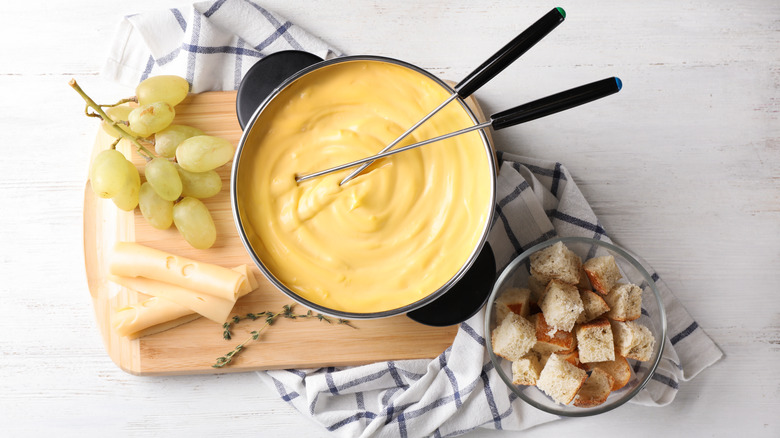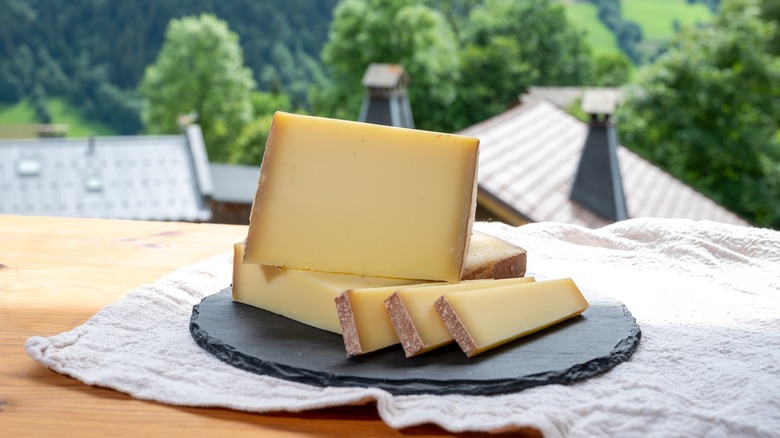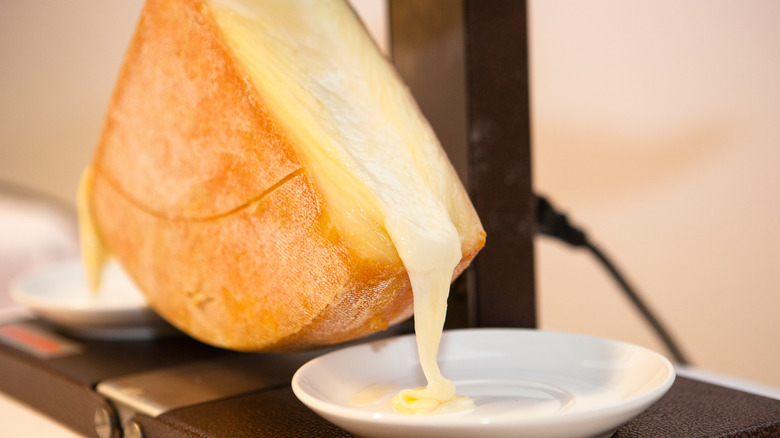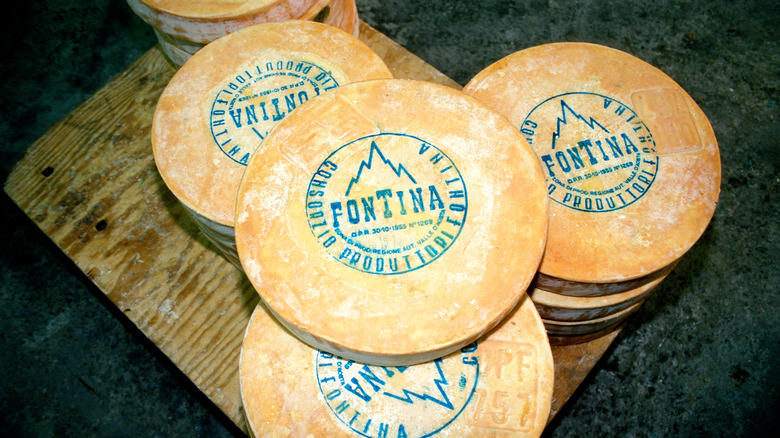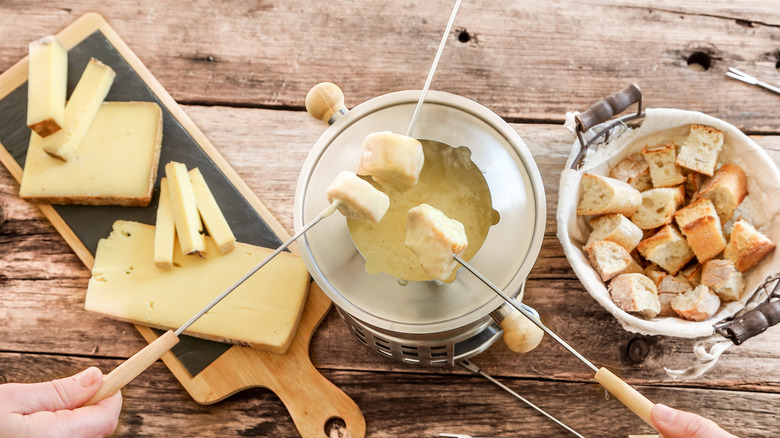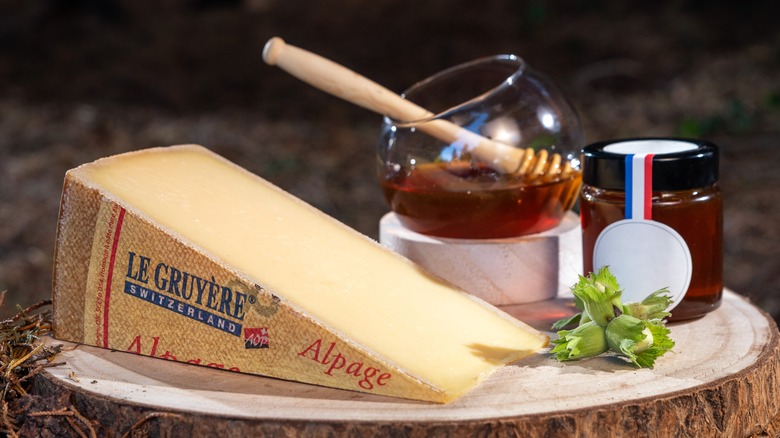13 Best Cheeses For Fondue, Ranked
It was only a matter of time before fondue parties became popular again. And why shouldn't they be? Gathering around a pot of warm gooey cheese and scooping it up with bites of toasted bread, potatoes, pickles, meats, and veggies sounds like a dream come true. This Swiss dish is classically made with Alpine cheeses, white wine, kirsch, cornstarch, garlic, black pepper, and nutmeg. But it's also a dish that lends itself well to experimentation since there are so many incredible cheese options out there.
In search of inspiration for our next great fondue, we reached out to Steffen Kenney and Jenny Armstrong, the cheese experts and owners of Stand Alone Cheese in Queens, NYC, and Katie Machen, the cheese shop's manager and communications director, for some appetizing insights. Kenney and Armstrong's fondue background runs deep, having first met while working at specialist Artisanal Fromagerie Bistro in NYC, which has since closed. Now fondue is a New Year's tradition for the husband and wife team since opening their own cheese shop. "We used to make more elaborate meals, but we've found fondue to be an easy and fun way to celebrate New Year's," says Kenney, "or any other occasion that's not during the summer."
So pull that vintage fondue pot out of the attic (or just buy a new one), and take a look at these popular cheeses that make great additions to your fondue mix.
13. Spreadable cheeses
Spreadable cheeses like cream cheese and Boursin cooking cream, might be the furthest from traditional fondue cheeses as it gets. But you're just as likely to find recipes online that include them as you are more established recipes. What makes these kinds of processed cheeses notable additions to our fondue lineup, is that many of them are both meltable and stable at warm temperatures.
Stabilizers like locust bean gum, carob bean gum, sodium alginate, and carrageenan help keep the fats and liquids in spreadable cheeses from breaking when melted. As far as flavor goes, "spreadable cheeses could get lost in a fondue or, depending on what it is, add too much flavor," says Kenney. "But Boursin could potentially make a fun herb-tasting fondue for the spring season."
You might also see other cheese spreads like Laughing Cow cheese, Velveeta, Neufchatel, and mascarpone added to fondue recipes. Mascarpone pulls double duty, making appearances in both cheese and dessert fondues. If possible only use as much of these cheeses as you need to help achieve a stable and creamy melted cheese texture with your fondue. We don't think any of these should be the star of your next fondue, but we'll admit that spreadable cheeses serve a purpose and could add a little something unexpected to a more modern fondue if used carefully.
12. Monterey Jack
Known for its supporting role in melted cheese dishes like macaroni and cheese, nachos, and grilled cheese sandwiches, Monterey Jack also pairs nicely with a wide variety of fondue cheeses. Whether you're making a more traditional fondue with Swiss and French Alpine cheeses, or a "Wisconsin fondue" with American-style cheeses, Monterey Jack smoothly blends into the background.
The semi-soft cow's milk cheese is milky and mild in flavor, making it a good choice as a foundation for stronger flavors. We'd suggest using Monterey Jack if you plan on making a larger batch of fondue but want to keep your cheese budget under control. Just make sure you don't use so much Monterey Jack that it dilutes the taste of the more developed cheese flavors in your fondue mix. For American-style fondue, you can also explore using a pepper jack or Colby jack blend for more heat or cheesy depth.
11. Blue cheese
There is no question that this pick is bound to be polarizing. "Using blue cheese is a commitment but if you love blue cheese you won't be disappointed," says Kenney, who has made a memorable version of the funky fondue with stilton and stout. It isn't a common choice for fondue, but considering it's already paired with crudités, olives, figs, cured meats, and spiced chicken wings, a warm blue cheese sauce doesn't seem like that far of a stretch.
There are two things you should consider when choosing a blue cheese for fondue. The first is texture. Firmer, crumblier blue cheeses have less moisture and may not melt as well as softer blue cheeses. You should also consider the strength of the cheese. Gorgonzola Dolce is an extremely popular Italian blue cheese that's soft, creamy, and relatively mild. On the other hand, a French Roquefort can be soft enough to spread, but often has stronger musty and ammonia flavors that can be overpowering for someone used to a milder blue cheese sauce. Also, be prepared for a fondue that has a blue or greenish tint to it.
Blue cheese fondue is a great opportunity to pair with robustly-flavored dippers, like strong meats, sweet and acidic fruits like apples, pears, and figs, whole grain and sourdough breads, olives, pickles, and crispy fresh vegetables. For a deluxe version, consider a blue cheese fondue with blackened crab recipe which pairs perfectly with potato chips.
10. Parmigiano-Reggiano
Parmesan is a hard cow's milk cheese from Italy that is typically aged for at least 12 months to develop its signature salty flavor. It should be noted that not all parmesan is alike and there are multiple variations of the cheese. Parmigiano-Reggiano is a protected cheese, meaning that it must be made in specific regions of Italy to precise standards to officially be given that title. While "parmesan" in the E.U. still holds the distinction of Reggiano, parmesan made in the U.S. is not required to meet the same standards—and is widely considered a sub-par copycat product.
While Parmigiano-Reggiano is one of the most popular cheeses in the world, it's not known for its exceptional melting texture. In fact, it's a crumbly, hard cheese with noticeable salt crystals, which is often served in small chunks on cheese plates or grated for cooking and topping finished dishes. It's not a classic fondue cheese, but given its popularity, and nutty and fruity flavor notes, it's no surprise that people would want to include parmesan in their fondue.
For the best results, we'd recommend buying a block of authentic Parmigiano-Reggiano and grating it directly into your hot fondue with an ultra-fine cheese grater. The parmesan has a better shot of smoothly melting into the fondue for the best flavor without too chunky of a texture. If you'd prefer a more affordable alternative to Parmigiano-Reggiano, consider Grana Padano cheese which provides a similar complex salty flavor and high production standards.
9. Gjetost Ski Queen
It's 100% cheese, but Gjetost Ski Queen tastes like caramel and makes for a sweet fondue instead of a savory one. This small Norwegian cheese cube is made from goat and cow's milk, and has a thick and smooth fudgy texture. The brown color and sweet flavor result from the natural sugars in the milk caramelizing while cooking, and further developing while aging for one to two months. The rindless semi-soft cheese melts into hot heavy cream, creating a surprising ganache-like fondue.
Pieces of toasted buttery bread can still be dipped into Ski Queen fondue, as well as fresh apple and pear slices. Anything that pairs well with caramel is a great fit with this style of fondue; chocolate, pretzels, lady fingers, graham crackers, marshmallows, pound cake or brownie bites, and fresh fruit are all ideal dipping candidates. Ski Queen fondue can also be complemented with amber ales, nutty brown ales, and crisp ciders. If you're feeling adventurous, add the ale or cider directly to the fondue for a sweet beer cheese-style fondue.
8. Emmentaler
If you've spent much time standing in front of a cheese case either at a specialty shop or even at the grocery store, you may already recognize Emmentaler. Dubbed the "King of Cheeses" in Switzerland, it's got that iconic Swiss cheese look, with large holes tunneling throughout. If you're picking up a piece made to the exacting Emmentaler AOP standards, it'll have the Swiss flag printed on the tough rind. Depending on who made the cheese, you may also see it under the names Emmental and Emmenthaler.
The raw cow's milk cheese is typically aged for 4 to 12 months but can mature longer for a more developed flavor. It's got gentle nutty and fruity notes, which are popular flavor profiles among Swiss semi-firm cheeses used for fondue. According to Kenney, adding Emmentaler to your fondue cheese mix will make a milder fondue, which is a great choice for those just beginning their Swiss fondue journey. If you can't find Emmentaler specifically, look for Jarlsberg, the Norwegian equivalent of Swiss cheese. It has a similar flavor profile and texture and is widely available in grocery stores with cheese cases.
7. Muenster
There are two kinds of Muenster cheese. French Muenster is a mild and soft washed-rind cheese from the Alsatian region of Eastern France, a stone's throw from Germany and Switzerland. American Muenster is a mild, semi-soft processed cow's milk cheese, similar to a mild jack cheese, with an annatto-colored edible rind. While both cheeses could potentially be added to fondue, here we're referring to the American version of the cheese.
American Muenster is an especially good melting cheese, with the ultra-creamy texture of processed American cheese when it's warm, and a slightly more complex generically cheesy flavor. Most versions of this cheese are mild, but some longer-aged brands have a slightly stronger pungent aroma vaguely reminiscent of its washed-rind French cousin. Muenster can be mixed with Swiss cheese, cheddar, and Alpine cheeses for a contemporary spin on traditional Swiss fondue. It can be found at grocery stores everywhere, as well as delis where it's often used for sandwiches. Ideally, you should buy it by the block and grate it for melting into your fondue, although if it's only available sliced, that will work too, though you'll probably need several packages. Just cut the slices into smaller pieces in advance for easier melting.
6. Cheddar
It's unlikely that you'll find cheddar in a traditional Swiss fondue, but in the U.S. it's a popular cheese choice to put in your pot. Not only does cheddar appeal to a wide audience, but it's also easy to find. Most grocery stores sell a good selection of cheddar cheeses in block form, but you can also head to your favorite local fromagerie for a selection of artisan-style cheddars that you won't be able to find at larger retailers.
When choosing a cheddar, Machen suggests looking for one "with a high melting point, like the 1-Year Cheddar from Shelburne Farms in Vermont." She points out that the crumblier the cheddar is, the more difficulty it will have melting smoothly. Generally speaking, younger cheddars have a higher moisture content and are less crumbly. Sharper, aged cheddars have a more developed flavor, but a lower moisture content and are more prone to crumbling. With that said, you should steer clear of pre-shredded cheddar cheeses, which dry out faster and are often made with additional ingredients like potato starch and powdered cellulose to prevent caking.
Since cheddar has a stronger flavor than some of the traditional cheeses used for fondue, you can get a little more creative with your flavor additions. Consider tossing herbs and spices like bay leaf, garlic, nutmeg, mustard powder, and pepper into the pot along with the cheese. Instead of wine (or in addition to it), add stock, beer, or a dash of Worcestershire sauce.
5. Comté
You'll notice as this list progresses, there's a specific style of cheese popularly used for traditional fondue: Alpine cheese. And one of our favorite Alpine cheeses is Comté. Made in the historical French region of Comté that shares a border with Switzerland, this cheese comes from only about 140 small-scale regional cheesemakers, called fruitières. Like most Alpine cheeses, Comté is aged anywhere from four months to three years and has a smooth texture that's great for melting. Often nutty and buttery, Comté can also have floral and tropical fruit flavors, with some even tasting like fresh pineapple. It's a complex cheese that doesn't come on too strong and is easy to enjoy with a nice variety of accouterments.
Comté can be a fun addition to your fondue, but there are a few logistical drawbacks to it. Since it's made by fewer producers than some of the other cheeses on this list, it's not as readily available in the U.S. and can be difficult to find. In turn, the price of Comté can be on the higher end of the cheese spectrum. Younger Comté cheeses tend to run $20 to 25 per pound, while aged Comté can cost around $50 per pound. If you're lucky enough to lay your hands on some, it might be worth enjoying on its own to appreciate all of the subtleties of this cheese before adding it to your fondue.
4. Raclette
If you're into the hearty and hot Alpine cheese scene, you may already be familiar with raclette. Not only is it a tasty cheese to add to fondue, but raclette is also a melted cheese dish of its own. Whereas fondue is essentially a warm pot of melted cheese, raclette (the dish) involves heating a wedge of raclette (the cheese) until the outer layer of the cheese is gooey enough to be scraped off. The runny raclette cheese is typically scraped over potatoes, fresh or pickled vegetables, meats, or bread.
From a melting perspective, it makes sense to include raclette in fondue. It's a raw cow's milk from Switzerland, that's smooth and salty on the palate with hints of grassiness, and a light nuttiness and sweetness. Raclette has a washed rind that contributes to the flavor of the cheese as it ages. A younger raclette will offer a milder flavor, but a wheel that has aged longer will have a slightly sticky and darker-colored rind that lends a stronger pungent taste to the cheese. Keep that in mind when choosing a raclette to add to your fondue, as some people might be turned off by the stronger aged raclette aroma. There are both Swiss and French versions of raclette, although the majority of raclettes are made in the Swiss Alps.
3. Fontina
The majority of the top-rated and classic cheeses used for fondue are made in Switzerland, but that doesn't mean there aren't lovely options from other countries that will work too. The Alps extend into several famous cheese-making regions in Italy, so it's no surprise that Italians have their own version of fondue, called "fonduta" which is made primarily with fontina. However, unlike traditional Swiss and French fondues, fonduta doesn't necessarily include wine which is surprising given how prevalent wine is in Italian cooking and dining.
Fontina is very similar to the Swiss and French alpine cheeses commonly used for fondue. It's got a creamy texture that melts smoothly and offers buttery and earthy notes. The popular semi-hard washed-rind cow's milk cheese is usually aged for about 90 days. You should be able to find smaller pre-packaged blocks of fontina in the cheese case of your grocery store, although it's worth it to pick up a nicer wedge from your local cheese shop. If you decide to make fondue with fontina, consider using Italian sausage and bread as dippers. Freshly shaved truffles are also a delightful addition to the pot and instantly transform a fondue (or fonduta) feast into a luxury dining experience.
2. Vacherin Fribourgeois
Given that fondue is traditionally a Swiss indulgence, it shouldn't be all that surprising that our top picks for making a delicious cheese fondue come from Switzerland. Vacherin Fribourgeois is a distinctly Alpine cheese, ideal for fondue lovers who like their hot dipping cheese to come on a little stronger. The lightly brine-washed cheese offers a creamy semi-firm texture fantastic for melting with flavors of chestnuts and even some meaty notes shining through.
While this particular cheese might not be for everyone, it's popular enough in Switzerland to merit its own style of fondue. Moitié-moitié translated from French, literally means "half-half" and is a particular style of fondue made with half Gruyère cheese and half Vacherin Fribourgeois. Kenney tells us that it's the direction he'll go in when customers are looking for a slightly stronger fondue cheese. Those seeking an authentic Swiss fondue experience are sure to be delighted to find a store that sells Vacherin Fribourgeois. It's not likely that you'll find it in many grocery stores, so you'll need to head to your favorite artisan or imported cheese shop to get your hands on it.
1. Gruyère
Not only was a Gruyère recently awarded the distinction of "World Champion Cheese" at the World Champion Cheese Contest in 202 (for the second year in a row) but it's also the cheese often recommended by mongers for making the best fondue. "Gruyere is the one cheese I always suggest when someone is putting together a fondue," says Kenney. "[T]hen I usually find out if they want a stronger or milder fondue so we can pick out our other cheeses."
Aged for a minimum of five months and up to two years, Gruyère is a cheese type with a Protected Designation of Origin under European Union and UK law, much like Parmigiano Reggiano, Roquefort, and Havarti. The cheese is well-known for its appealing nutty taste, subtle sweetness, and delicate aromas. As Gruyère ages, it picks up meatier notes and develops salty crystals that add pops of flavor to the smooth and creamy paste.
Gruyère is known for its exceptional melting texture at any age, and aside from fondue, is often used for popular cheese dishes like French onion soup, macaroni and cheese, quiche, popovers and gougères, potatoes au gratin, and even grilled cheese sandwiches. So if you're planning on making cheese fondue, whether you're sticking to the classics or trying a more contemporary spin (French onion fondue, anyone?), Gruyère is the perfect place to start.
